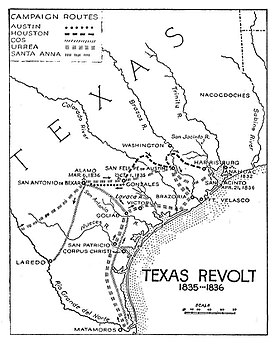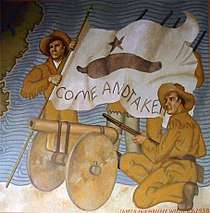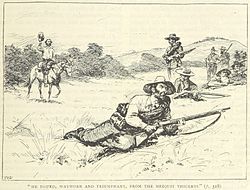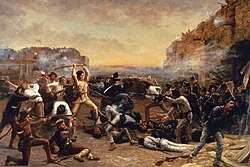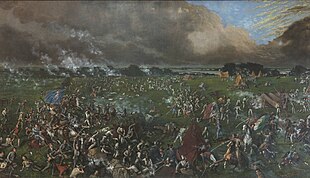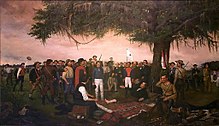Texian Army
[1][2] When Mexico gained its independence from Spain in 1821, the former Spanish province of Texas became part of the Mexican state Coahuila y Tejas.
[3] Many of the people who lived in Texas, which had included the land north of the Medina and the Nueces Rivers, 100 miles (161 km) northeast of the Rio Grande,[4] west of San Antonio de Bexar, and east of the Sabine River,[4][5][6] wished to be a separate state again.
Under President Antonio López de Santa Anna the government of Mexico began to drift towards a more centralist form.
[12] In September 1835, Colonel Domingo Ugartechea, the military commander of the Mexican forces at San Antonio de Bexar set troops to recover a small cannon that had been given to the Texian Militia of Gonzales for protection.
[15] On October 11, the disorganized volunteers elected Stephen F. Austin, who had settled Texas's first English-speaking colonists in 1821, as their commander-in-chief.
[16] Austin had only two months of military experience in the Missouri First Regiment of Mounted Militia under Colonel Alexander McNair, where he earned the rank of quartermaster sergeant, but he saw no combat.
[19] Still, Historian Paul Lack argues that "for a people of such fabled militance, the Texians turned out for army duty in the period of crisis at a low rate of participation".
Thirty-four percent of the volunteers came from the Nacogdoches district of far East Texas, an area where homes and families were not under threat.
[22] After the Texas victory in Bexar in early December, men began leaving the army and returning home.
[25] By the Battle of San Jacinto on April 21, new commander Sam Houston had a total of 1,282 recruits in the army.
[28] 67% of the Texians who volunteered were from the Brazos Department, an impressive number considering the heavy losses many of these areas had sustained in the March fighting.
This number was low both because many of the volunteers had perished at the Alamo or Coleto and because the area was now occupied by the Mexican army.
The majority of the men from Bexar who served in April were cavalry officers under the command of Colonel Juan Seguin.
[21] Several of the companies that formed in the United States, including the New Orleans Greys, purchased U.S. Army surplus uniforms before they arrived.
... Buckskin breeches were the nearest approach to uniform and there was wide diversity even there, some of them being new and soft and yellow, while others, from long familiarity with rain and grease and dirt, had become hard and black and shiny.
Here a broad brimmed sombrero overshadowed the military cap at its side; there, a tall "beegum" rode familiarly beside a coonskin cap, with the tail hanging down behind, as all well regulated tails should do ... here a bulky roll of bed quilts jostled a pair of "store " blankets; there the shaggy brown buffalo robe contrasted with a gaily colored checkered counterpane on which the manufacturer had lavished all the skill of dye and weave known to art ... in lieu of a canteen, each man carried a Spanish gourd....
Here a big American horse loomed above the nimble Spanish pony, there a half-broke mustang pranced beside a sober methodical mule.
A fantastic military array to a casual observer, but the one great purpose animating every heart clothed us in a uniform more perfect in our eyes than was ever donned by regulars on dress parade.
Any man who enlisted in the regular division would receive $24 in cash, the rights to 800 acres (320 ha) of land, and instant Texas citizenship.
[35] Houston was then ordered to travel to East Texas to broker a treaty that would allow the Cherokee to remain neutral in the conflict.
On January 6, 1836, Colonel James C. Neill, commander of the remaining 100 troops in Bexar, wrote to the council: " there has ever been a dollar here I have no knowledge of it.
The clothing sent here by the aid and patriotic exertions of the honorable Council, was taken from us by arbitrary measures of Johnson and Grant, taken from men who endured all the hardships of winter and who were not even sufficiently clad for summer, many of them having but one blanket and one shirt, and what was intended for them given away to men some of whom had not been in the army more than four days, and many not exceeding two weeks.
[41] Before they left, the Mexican army launched the Battle of the Alamo, and all of the Texian soldiers who had been stationed in Bexar were killed.
On hearing the news of the massacre at the Alamo, Houston ordered his army to retreat and burned the town of Gonzales as they left.
[47] The Texas Revolution essentially ended on April 21, when the Texian Army routed a Mexican force and captured Santa Anna at the Battle of San Jacinto.
[47] For six months David G. Burnet, ad interim President of the Republic, had diligently maintained the army laws set forth by the Consultation in December 1835.




